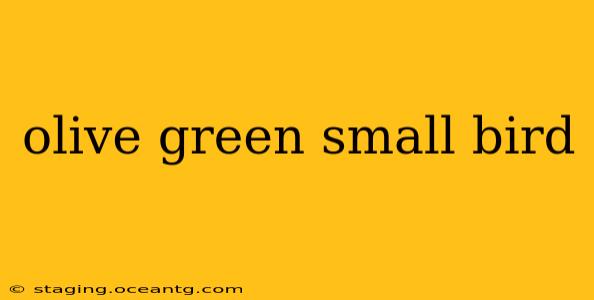Spotting a small, olive green bird can be a delightful experience, but identifying the exact species requires a closer look. Many birds share this coloration, making identification a fun challenge for birdwatchers of all levels. This guide will help you narrow down the possibilities, providing key features to look for and answering common questions.
What kind of small olive green bird is this?
This is the most common question, and the answer depends heavily on your location. To help narrow it down, consider these factors: location (country, state, even specific region), habitat (forest, backyard, wetland), time of year (migration patterns can dramatically alter bird populations), and any distinctive markings beyond the overall olive green hue. A photo or detailed description is invaluable in precise identification.
What are some common small olive green birds?
Several bird families boast olive green members. Here are a few examples to get you started:
-
Warblers: Many warblers exhibit olive green plumage, often with yellow or other contrasting colors on their wings, breasts, or throats. They are typically found in wooded areas and are known for their active foraging behavior. Specific examples could include the Common Yellowthroat (though not entirely olive green), the Black-throated Green Warbler, or the Yellow-rumped Warbler (which shows significant variation in plumage).
-
Vireos: These birds are often olive-green above and yellowish or whitish below. They tend to have relatively short, stout bills and are found in a variety of habitats, including forests and woodlands.
-
Flycatchers: Some flycatchers exhibit olive-green coloration, particularly the female or immature birds. Their identification often relies on observing their behavior (catching insects in mid-air) and subtle markings that might not be immediately obvious.
-
Woodpeckers: While not predominantly olive green, some woodpecker species might have olive-green tones within their plumage. Look for other identifying features such as their size, bill shape, and distinctive drumming behavior.
Remember, this is just a small sampling. The precise species will depend greatly on your geographic location and the bird's specific characteristics.
How can I identify a small olive green bird?
Accurate identification demands careful observation. Consider these key points:
- Size: How big is the bird relative to other birds in the area, or to common objects (like your hand)? Even a rough estimate is helpful.
- Shape and posture: Is its beak long and slender, short and stout, or something in between? Does its tail have distinctive features like a long central tail feather or a fanned appearance? How does it hold itself – upright, hunched, or perched?
- Markings: Look beyond the overall olive green. Are there any stripes, spots, or other colors on the wings, tail, breast, or head? Even subtle differences in shade can be important.
- Behavior: What is the bird doing? Is it foraging on the ground, flitting through branches, or hovering to catch insects?
- Sound: Bird songs and calls are often species-specific. A recording app on your smartphone can aid in capturing these sounds for later identification.
- Habitat: Where did you see the bird? This is a critical piece of the puzzle.
What resources can help me identify a small olive green bird?
Several excellent resources are available to help with bird identification:
- Field guides: Regional field guides are invaluable tools. Choose one specific to your area.
- Online databases: Websites like All About Birds (allaboutbirds.org) and eBird (ebird.org) offer extensive information, photos, and audio recordings of various bird species. These can help narrow down possibilities based on your region and observations.
- Bird identification apps: Several apps utilize image recognition technology or allow for inputting features to suggest possible species.
By combining careful observation with the use of appropriate resources, you can significantly improve your chances of correctly identifying that small, olive green bird. Happy birding!
